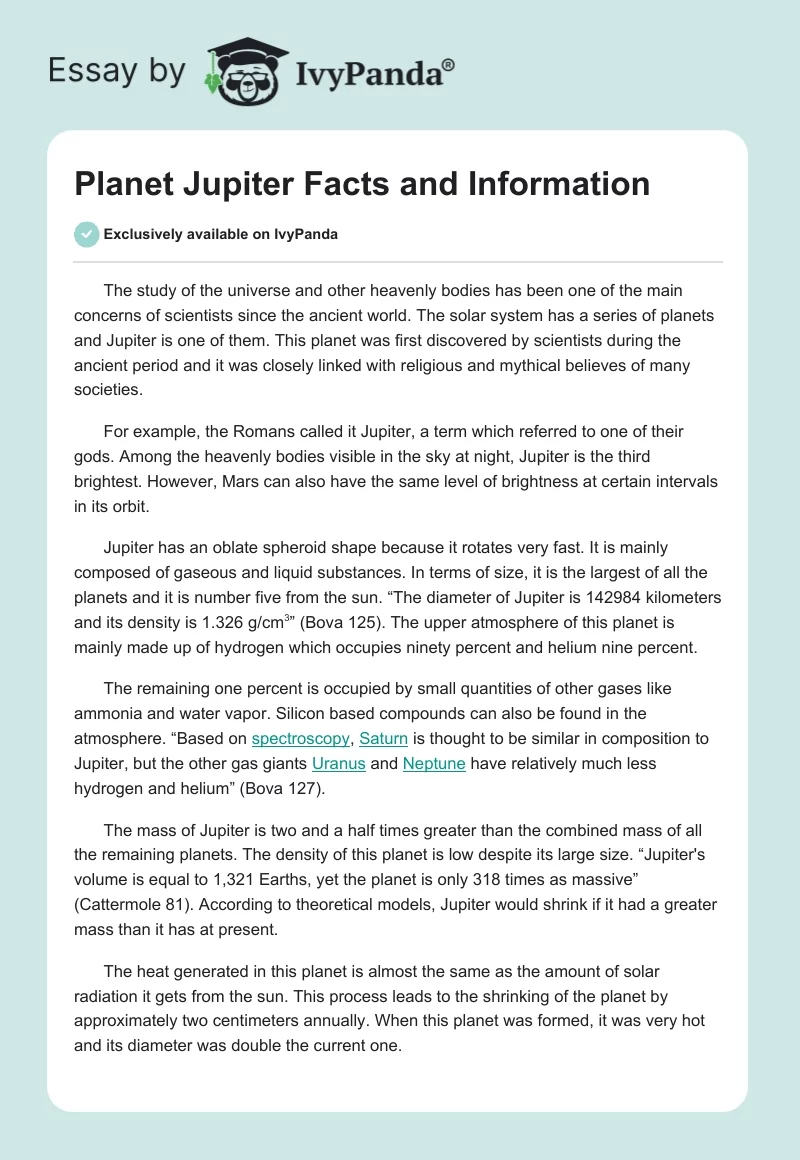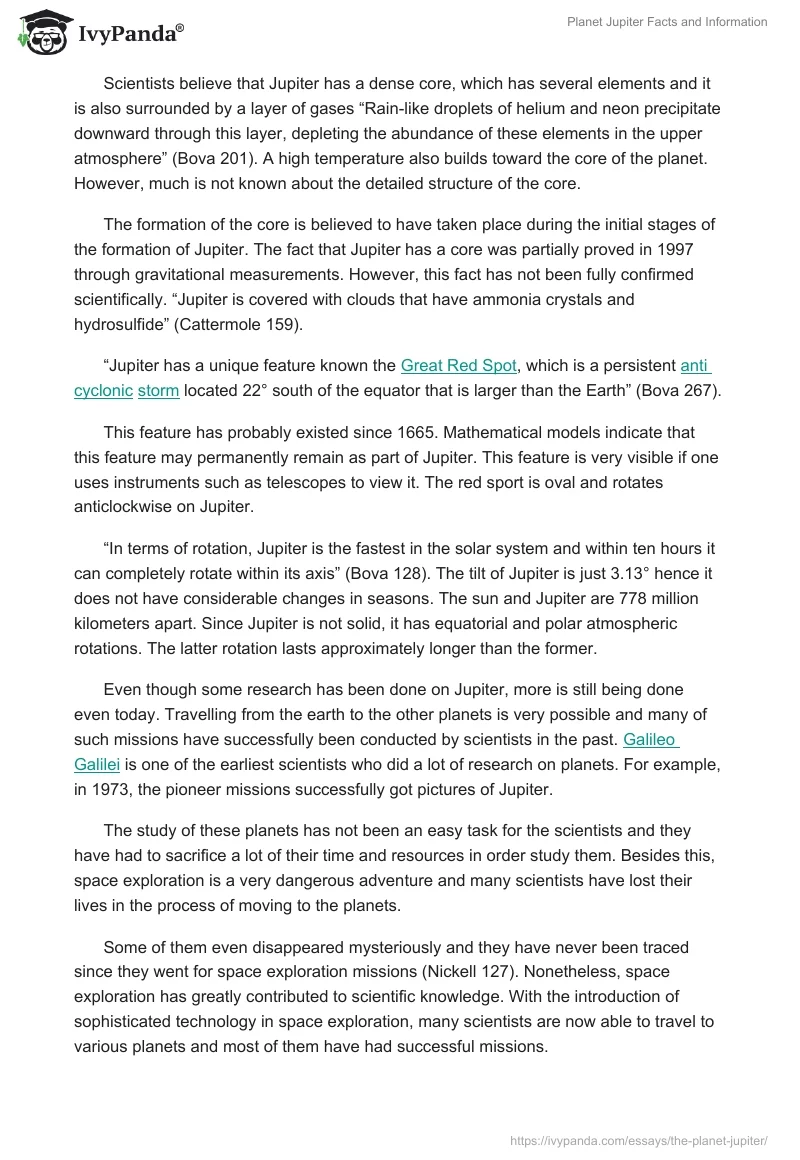The study of the universe and other heavenly bodies has been one of the main concerns of scientists since the ancient world. The solar system has a series of planets and Jupiter is one of them. This planet was first discovered by scientists during the ancient period and it was closely linked with religious and mythical believes of many societies.
For example, the Romans called it Jupiter, a term which referred to one of their gods. Among the heavenly bodies visible in the sky at night, Jupiter is the third brightest. However, Mars can also have the same level of brightness at certain intervals in its orbit.
Jupiter has an oblate spheroid shape because it rotates very fast. It is mainly composed of gaseous and liquid substances. In terms of size, it is the largest of all the planets and it is number five from the sun. “The diameter of Jupiter is 142984 kilometers and its density is 1.326 g/cm3” (Bova 125). The upper atmosphere of this planet is mainly made up of hydrogen which occupies ninety percent and helium nine percent.
The remaining one percent is occupied by small quantities of other gases like ammonia and water vapor. Silicon based compounds can also be found in the atmosphere. “Based on spectroscopy, Saturn is thought to be similar in composition to Jupiter, but the other gas giants Uranus and Neptune have relatively much less hydrogen and helium” (Bova 127).
The mass of Jupiter is two and a half times greater than the combined mass of all the remaining planets. The density of this planet is low despite its large size. “Jupiter’s volume is equal to 1,321 Earths, yet the planet is only 318 times as massive” (Cattermole 81). According to theoretical models, Jupiter would shrink if it had a greater mass than it has at present.
The heat generated in this planet is almost the same as the amount of solar radiation it gets from the sun. This process leads to the shrinking of the planet by approximately two centimeters annually. When this planet was formed, it was very hot and its diameter was double the current one.
Scientists believe that Jupiter has a dense core, which has several elements and it is also surrounded by a layer of gases “Rain-like droplets of helium and neon precipitate downward through this layer, depleting the abundance of these elements in the upper atmosphere” (Bova 201). A high temperature also builds toward the core of the planet. However, much is not known about the detailed structure of the core.
The formation of the core is believed to have taken place during the initial stages of the formation of Jupiter. The fact that Jupiter has a core was partially proved in 1997 through gravitational measurements. However, this fact has not been fully confirmed scientifically. “Jupiter is covered with clouds that have ammonia crystals and hydrosulfide” (Cattermole 159).
“Jupiter has a unique feature known the Great Red Spot, which is a persistent anti cyclonic storm located 22° south of the equator that is larger than the Earth” (Bova 267).
This feature has probably existed since 1665. Mathematical models indicate that this feature may permanently remain as part of Jupiter. This feature is very visible if one uses instruments such as telescopes to view it. The red sport is oval and rotates anticlockwise on Jupiter.
“In terms of rotation, Jupiter is the fastest in the solar system and within ten hours it can completely rotate within its axis” (Bova 128). The tilt of Jupiter is just 3.13° hence it does not have considerable changes in seasons. The sun and Jupiter are 778 million kilometers apart. Since Jupiter is not solid, it has equatorial and polar atmospheric rotations. The latter rotation lasts approximately longer than the former.
Even though some research has been done on Jupiter, more is still being done even today. Travelling from the earth to the other planets is very possible and many of such missions have successfully been conducted by scientists in the past. Galileo Galilei is one of the earliest scientists who did a lot of research on planets. For example, in 1973, the pioneer missions successfully got pictures of Jupiter.
The study of these planets has not been an easy task for the scientists and they have had to sacrifice a lot of their time and resources in order study them. Besides this, space exploration is a very dangerous adventure and many scientists have lost their lives in the process of moving to the planets.
Some of them even disappeared mysteriously and they have never been traced since they went for space exploration missions (Nickell 127). Nonetheless, space exploration has greatly contributed to scientific knowledge. With the introduction of sophisticated technology in space exploration, many scientists are now able to travel to various planets and most of them have had successful missions.
Works Cited
Bova, Ben. Jupiter. New York: Wiley, 2000.
Cattermole, Peter. Earth and Other Planets: Geology and Space Research. New York: Oxford University Press, 1995.
Nickell, Duane. Guidebook for the Scientific Traveler: Visiting Astronomy and Space Exploration Sites Across America. New York: Rutgers University Press, 2008.


